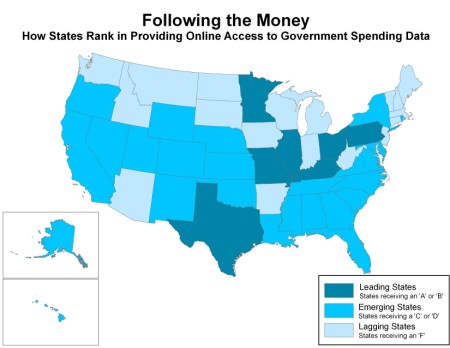
New Report: Following the Money
The ability to see how the government uses the public purse is fundamental to democracy - it allows citizens to monitor spending and hold elected officials accountable. Over the past five years, at least 32 states have mandated the creation of online databases that contain “checkbook-level” information on government expenditures, allowing citizens to monitor government spending in a way unheard of just a short time ago.
“We might hope to see the finances of the Union as clear and intelligible as a merchant’s books, so that every member of Congress and every man of any mind in the Union should be able to comprehend them, to investigate abuses, and consequently to control them.”
– Thomas Jefferson, 1802
The ability to see how the government uses the public purse is fundamental to democracy – it allows citizens to monitor spending and hold elected officials accountable. Over the past five years, at least 32 states have mandated the creation of online databases that contain “checkbook-level” information on government expenditures, allowing citizens to monitor government spending in a way unheard of just a short time ago.
States have already begun to reap the benefits of improved transparency and accountability. Spending Web sites bolster citizen confidence and save the government money. In the two years following the launch of its transparency Web site, for example, the Texas comptroller reported $4.8 million in savings from more efficient government administration.
In our report, Following the Money: How the 50 States Rate in Providing Online Access to Government Spending Data, we evaluate the progress of states towards “Transparency 2.0” – a new standard of comprehensive, one-stop, one-click budget accountability and accessibility. These states can be easily classified in three categories in the Transparency 2.0 movement – leading, emerging and lagging states.
Seven states have become leaders in the drive toward Transparency 2.0 by establishing user-friendly, searchable Web sites that provide detailed information on government spending. These states provide detailed information on government contracts, specifying not only the recipients of the awards but the purpose and acquisition method as well. Three of the leading states even allow residents to view PDF versions of the official contracts. Many of these leading states also provide information on other areas of government spending. Five of the states, for example, provide tax subsidy information through their Web sites, while all seven include data on grants and other economic development incentives. Two of the states, Illinois and Kentucky, even include data on the number of jobs created by each expenditure.
Twenty-five additional states have made the initial steps toward online transparency by launching Web sites with detailed information on state spending. These sites, however, lack the searchability and breadth of information that characterize the databases of the leading states. Only 11 of the emerging states, for example, provide detailed information on specific expenditures and only three include data on tax expenditures.
Finally, 18 states lag behind the transparency movement and have only taken small steps towards improving government accountability. Four of the states in this category – Arizona, New Jersey, South Dakota and Washington – have launched transparency Web sites that do not provide information on individual government expenditures. The remaining states have not yet established transparency Web sites that allow citizens to monitor government spending.
In the midst of a budget crisis, it is especially important for residents to be able to monitor the public funds and hold their elected officials accountable. The emerging and lagging states should follow the example set by the leading states and establish comprehensive, one-stop, one-click searchable Web sites that allow citizens to easily follow the money. The leading states should continue setting the standard for Transparency 2.0 by expanding the amount of information they provide online.

Topics
Authors
Tony Dutzik
Associate Director and Senior Policy Analyst, Frontier Group
Tony Dutzik is associate director and senior policy analyst with Frontier Group. His research and ideas on climate, energy and transportation policy have helped shape public policy debates across the U.S., and have earned coverage in media outlets from the New York Times to National Public Radio. A former journalist, Tony lives and works in Boston.
Find Out More

The Buffalo Bill: New York’s $1.2 billion subsidy for the Bills’ new stadium

Our transportation finance system doesn’t work. Here’s how to fix it.

The titans of “Main Street”: Mission creep in a key Fed rescue program threatens public trust

